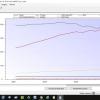How does a fuel injector work?
A fuel injector is nothing more than a high-speed valve for gasoline. An engine computer or controller is used to control the fuel injector. Contrary to popular belief, this is not done by sending power to the injector. Fuel injectors are normally fed power whenever the ignition key is on. The computer controls the negative, or ground side, of the circuit. When the computer provides the injector with a ground, the circuit is completed and current is allowed to flow through the injector. This energizes an electromagnetic coil inside the injector, which pulls a sealing mechanism (pintle, ball, or disc) away from its seat. This makes it possible for fuel to flow through the injector and into the engine. When the computer removes the electrical ground to the injector, the electromagnetic coil becomes demagnetized and a spring forces the pintle, ball, or disc shut to cut off fuel flow. Even at an engine speed of just 1000 RPM , this is done hundreds of times per minute.
What do the terms “static” and “duty cycle” mean?
An injector in an engine turns on and off very quickly to control the amount of fuel delivered. The amount of time an injector is turned on and delivering fuel is known as the duty cycle. This is measured as a percent, so 50% duty cycle indicates that the injector is held open and held closed for an equal amount of time. When the engine needs more fuel, the time that the injector stays on (its duty cycle) increases so that more fuel can flow into the engine. If an injector stays on all the time, it is said to be static (wide open, or 100% duty cycle). Injectors should not go static in a running engine. If an injector is static in a running engine (open 100% of the time), that injector is no longer able to control fuel delivery. This could be an indication that the injector is too small for the needs of the engine. Injector duty cycle should usually not exceed 80% in a running engine at any time.
What is impedance?
Impedance is the electrical resistance of the electromagnetic coil inside the injector. This is measured in ohms and can be determined with an ohmmeter. Injectors are classified as either high-impedance (also known as “saturated”) or low-impedance (known as “peak and hold”). High-impedance injectors usually range from 11 to 16 ohms of impedance, while low-impedance injectors usually range from 0.7 to 5 ohms of impedance (these impedance numbers are based on what is currently available in the consumer market and are subject to change). Most OEM engine computers are designed to control high-impedance fuel injectors. Low-impedance injectors are generally preferred for racing or ultra-high performance use because they respond more quickly, but aftermarket engine controllers are usually required to control them.
What is an injector’s static flow rate?
Manufacturers rate fuel injectors by the maximum amount of fuel that they can flow in a given amount of time. This measurement is taken with the injector on 100% of the time (100% duty cycle, or wide open) and with the fuel at a given pressure (usually 43.5psi). For example, a 19 pound per hour (Lb/Hr.) injector flow 19 pounds of fuel in one hour at 100% duty cycle and 43.5 psi of fuel pressure. Injectors in imported vehicles are often rated in cubic centimeters per minute (cc/min) instead of pounds per hour. This is also done at 100% duty cycle.
If injectors should not exceed 80% duty cycle under operating conditions, why do manufacturers rate them at 100% duty cycle?
A test at 100% duty cycle is used to determine the maximum amount of fuel that will flow through an injector in a given time. This test is useful for determining whether an injector’s internal fuel passages were machined properly, but it does not check an injector’s ability to cycle on or off. It is usually not recommended to run an injector at more than 80% duty cycle under actual driving conditions. This 80% duty cycle operating limit is taken into account to make sure the injector will be large enough to feed the engine under actual operating conditions and will not starve the engine for fuel.

Can you alter injectors to increase their static flow rates?
Absolutely not. It is sometimes possible to increase an injector’s static flow rate at a given pressure by machining or enlarging the pintle or internal passages of the injector. However, this procedure is usually not a good idea! A fuel injector cycles on and off thousands of times per minute to feed an engine the proper amount of fuel. Because of this, the electromagnetic coil andpintle of an injector are very carefully matched to one another. Modifying the pintle or other portions of the injector may cause it to flow more fuel at its limits (wide open or statically), but at lower engine speeds the injector will be extremely inconsistent. This creates drivability problems, idle fluctuations, higher emissions, rich/lean conditions, etc. We have performed extensive laboratory tests on many modified injectors and have yet to find one that performs as well as an unmodified injector of the same capacity.























